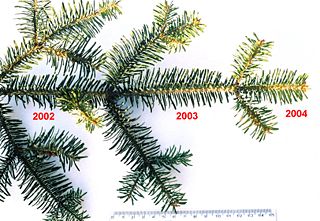
The Monimiaceae is a family of flowering plants in the magnoliid order Laurales. It is closely related to the families Hernandiaceae and Lauraceae. It consists of shrubs, small trees, and a few lianas of the tropics and subtropics, mostly in the southern hemisphere. The largest center of diversity is New Guinea, with about 75 species. Lesser centres of diversity are Madagascar, Australia, and the neotropics. Africa has one species, Xymalos monospora, as does Southern Chile. Several species are distributed through Malesia and the southwest Pacific.

Siparunaceae is a family of flowering plants in the magnoliid order Laurales. It consists of two genera of woody plants, with essential oils: Glossocalyx in West Africa and Siparuna in the neotropics. Glossocalyx is monospecific and Siparuna has about 74 known species.
The name Catuaba is used for the infusions of the bark of a number of trees native to Brazil. The most widely used barks are derived from the trees Trichilia catigua and Erythroxylum vaccinifolium. Other catuaba preparations use the bark of trees from the following genera or families: Anemopaegma, Ilex, Micropholis, Phyllanthus, Secondatia, Tetragastris and species from the Myrtaceae.

Siparuna is a genus of plants belonging to the family Siparunaceae. These aromatic evergreen trees and shrubs are found throughout the Neotropic ecozone. Over 70 species have been described.
Siparuna gentryana is an evergreen monoecious tree which grows to 20 m in height. It is found in primary forest habitats in western Ecuador and Colombia. It is similar to the more widespread Siparuna cristata but can be distinguished by its much smaller fruits which are spiny rather than smooth.
Siparuna lozaniana is an evergreen dioecious shrub which usually grows to 8 m in height. It is found in wet montane forest habitats in central Colombia. It can be distinguished from Colombian congeners such as Siparuna calantha and Siparuna petiolaris by the combination of leathery oblanceolate or obovate leaves and smooth rather than spiny fruits.
Siparuna vasqueziana is an evergreen dioecious shrub which grows to 5 m in height. It is found in primary forest habitats in Amazonian Peru. It can be distinguished from all other Siparuna species by its yellow flowers with exceptionally long tepals.
Siparuna campii is a species of plant in the Siparunaceae family. It is endemic to Ecuador.
Siparuna cascada is a species of plant in the Siparunaceae family. It is endemic to Ecuador.
Siparuna croatii is a species of plant in the Siparunaceae family. It is endemic to Ecuador.
Siparuna eggersii is a scrambling, large shrub in the Siparunaceae family. It is endemic to Ecuador, where it is endangered due to habitat destruction. It has glabrous leaves and fig-like, red fruit with a lemon scent.
Siparuna guajalitensis is a species of plant in the Siparunaceae family. It is endemic to Ecuador.
Siparuna multiflora is a species of plant in the Siparunaceae family. It is endemic to Ecuador.
Siparuna palenquensis is a species of plant in the Siparunaceae family. It is endemic to Ecuador.
Siparuna piloso-lepidota is a species of plant in the Siparunaceae family. It is endemic to Ecuador.
S. nigra is an abbreviation of a species name. In binomial nomenclature the name of a species is always the name of the genus to which the species belongs, followed by the species name. In S. nigra the genus name has been abbreviated to S. and the species has been spelled out in full. In a document that uses this abbreviation it should always be clear from the context which genus name has been abbreviated.
S. petiolaris may refer to:
Hyaleucerea lemoulti is a moth of the subfamily Arctiinae. It was described by Schaus in 1905. It is found in Ecuador and French Guiana.
S. poeppigii may refer to:





